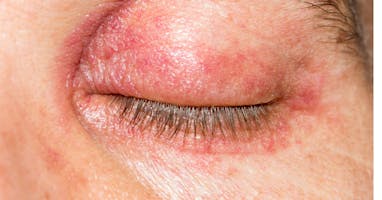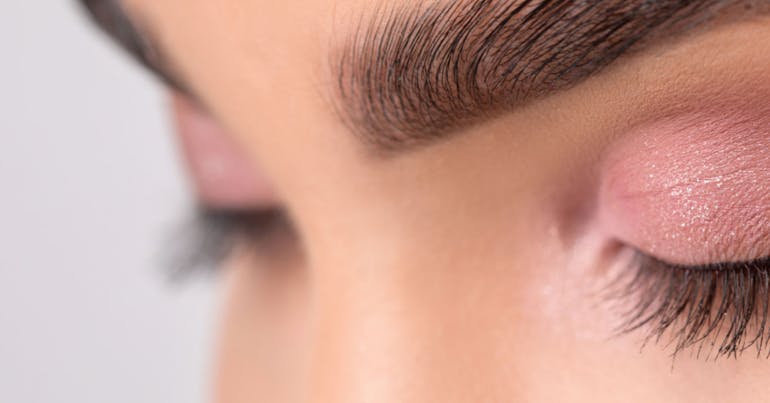Understanding Blepharitis: An Introduction
Blepharitis, a common eye condition, is characterised by the inflammation of the eyelids, particularly where the eyelashes grow. This condition often results in red and irritated eyes, a common concern for many individuals worldwide.
The prevalence of Blepharitis is widespread, affecting people of all ages and demographics. It is not limited to any particular region or ethnicity, making it a global eye health concern.
The human eyelid is a complex structure designed to protect the eye and maintain its health. One of its most important features is the oil glands, also known as Meibomian glands. These glands are located along the edge of the eyelids and play a crucial role in eye health by producing an oily substance that forms the top layer of the tear film. This oily layer prevents the evaporation of the watery layer beneath it, thus keeping the eyes lubricated. When these oil glands become clogged or irritated, it can lead to conditions like Blepharitis.
There are two primary types of Blepharitis - Anterior and Posterior. Anterior Blepharitis affects the outside of the eyelid where the eyelashes are attached. It's often caused by bacteria or dandruff from the scalp and eyebrows. On the other hand, Posterior Blepharitis affects the inner edge of the eyelid that comes into contact with the eyeball and is usually caused by problems with the oil glands in this area. Understanding these types can help in better management and treatment of the condition.
Unravelling Blepharitis: Causes, Symptoms, and Diagnosis
Uncovering the Causes
Blepharitis can be attributed to a variety of causes, each contributing to the inflammation of the eyelids in its unique way. Let's delve into some of the most common ones:
- Excess Bacteria: Our skin naturally hosts a variety of bacteria, but an overgrowth, especially around the eyelids, can lead to Blepharitis.
- Blocked Oil Gland on Eyelid: The oil glands on our eyelids can sometimes get blocked, leading to inflammation.
- Hormone Problems: Certain hormonal imbalances can also contribute to the development of Blepharitis.
- Allergies: Allergic reactions to certain substances can cause inflammation of the eyelids.
- Infection with a Virus: Viral infections can also lead to Blepharitis.
- Skin Conditions: Certain skin conditions like rosacea or seborrheic dermatitis can cause Blepharitis.
- Eyelash Mites or Lice: Infestation with tiny organisms like mites or lice can cause inflammation of the eyelids.
- Medication Side Effects: Some medications can cause side effects that include Blepharitis.
- Malfunctioning Oil Gland: Problems with the functioning of the oil glands in the eyelids can lead to Blepharitis.
Recognising the Symptoms
Blepharitis often presents with a range of symptoms that can affect one's quality of life. These include:
- Itchy eyelids
- Swollen eyelids
- Red or inflamed eyelids
- A burning sensation in the eyes
- Oily eyelids
- A feeling that something is in or on your eyes
- Red eyes
- Watery eyes
- A crust on your eyelashes or in the corners of your eyes
- Sensitivity to light
These symptoms can vary in intensity and frequency, and if you experience any of them, it's important to seek medical advice.

The Diagnosis Process
Diagnosing Blepharitis typically involves a thorough examination of your eyes and eyelids. Your doctor may use a specialised magnifying tool to closely examine your eyelids for signs of inflammation and to check the functioning of your oil glands. In some cases, a swab of your eye may be taken to check for the presence of bacteria, fungi, or viruses. Remember, early diagnosis can lead to more effective treatment and better outcomes.
Risk Factors
Certain factors can increase your risk of developing Blepharitis. These include:
- Having dandruff on your scalp or eyebrows
- Having an allergic reaction to makeup or other cosmetic products
- Having certain skin conditions like rosacea or seborrheic dermatitis
- Having eyelash mites or lice
- Experiencing side effects from certain medications
- Having a malfunctioning oil gland
Understanding these risk factors can help in early detection and prevention of Blepharitis.
For more information on Blepharitis, its causes, symptoms, and diagnosis, you can visit WebMD. Remember, your health is in your hands, and staying informed is the first step towards wellness.
Navigating Blepharitis: Treatment, Complications, and Prevention
Exploring Treatment Options
When it comes to treating Blepharitis, a variety of options are available. The choice of treatment often depends on the underlying cause of the condition. Here are some common treatment methods:
- Warm Compresses: Applying a warm compress to the affected eyelids can help soften crusts and loosen oily debris, providing relief from symptoms.
- Eyelid Scrubs: Regularly cleaning the eyelids with a solution of baby shampoo and warm water can help keep the eyelids clean and reduce symptoms.
- Antibiotics: If the inflammation is caused by a bacterial infection, your doctor may prescribe antibiotics in the form of ointments, drops, or oral medication.
- Eye Drops: Lubricating eye drops can help alleviate dryness and irritation caused by Blepharitis.
- Skin and Eyelid Hygiene: Maintaining good hygiene practices, such as washing your face regularly and removing makeup before bed, can help manage symptoms and prevent further irritation.
- Omega-3s Fish Oil: Some people find relief from their symptoms with omega-3 fatty acids, which may help the oil glands in the eyelids work better.
Potential Complications
While Blepharitis is typically not a serious condition, if left untreated, it can lead to several complications. These can include:
- Loss of eyelashes
- Excess tears
- Dry eyes, potentially increasing the chances of a cornea infection
- Clogged glands that might get infected (stye) or form a lump (chalazion)
- Scarring on your eyelids
- Cornea inflammation
It's important to seek medical advice if you suspect you have Blepharitis to avoid these potential complications.
Prevention and Management
While Blepharitis can't always be prevented, there are measures you can take to reduce your risk and manage the condition:
- Maintain good eyelid hygiene by washing your face and eyelids regularly.
- Remove all eye makeup before bed.
- Avoid using eyeliner on the back edges of your eyelids, behind the lashes.
- If you're in the early stages of treating Blepharitis, avoid using makeup to prevent further irritation.
- Regularly check your eyelids for signs of inflammation and seek medical advice if you notice any changes.
Remember, managing Blepharitis is a long-term commitment. With the right care and treatment, you can control the symptoms and prevent complications. For more information on managing Blepharitis, you can visit Healthline.
Remember, your eyes are your windows to the world. Take good care of them!
Frequently Asked Questions About Blepharitis
Is Blepharitis Contagious?
No, Blepharitis is not contagious. It is an inflammation of the eyelids usually caused by an overgrowth of bacteria that are normally found on the skin, blocked oil glands near the base of the eyelashes, or allergies.
Can Blepharitis Cause Permanent Damage?
In most cases, Blepharitis does not cause permanent damage to your vision. However, if left untreated, it can lead to more serious conditions such as a corneal infection or chronic pink eye, which could potentially harm your vision. Therefore, it's important to seek medical advice if you suspect you have Blepharitis.
How Long Does It Take for Blepharitis to Clear Up?
The length of time it takes for Blepharitis to clear up can vary greatly depending on the individual and the severity of the condition. With proper treatment, symptoms can improve significantly within a few weeks. However, long-term management is often necessary to keep symptoms at bay.
Can I Wear Makeup If I Have Blepharitis?
If you have Blepharitis, it's recommended to avoid wearing eye makeup, especially during a flare-up. Makeup can irritate the eyes and potentially worsen the condition. If you must wear makeup, ensure it is hypoallergenic and always remove it thoroughly before bed.
What Lifestyle Changes Can Help Manage Blepharitis?
Several lifestyle changes can help manage Blepharitis. These include maintaining good eyelid hygiene, using warm compresses on the eyes, avoiding eye irritants, and taking omega-3 fatty acid supplements. It's also important to manage any underlying conditions that may contribute to Blepharitis, such as dandruff or rosacea.
Can Blepharitis Return After Treatment?
Yes, Blepharitis can return after treatment. It is often a chronic condition, meaning it can come and go over time. Regular eyelid hygiene can help prevent flare-ups and manage the condition in the long term.
For more information on Blepharitis, you can visit WebMD. Remember, your eyes are precious, take good care of them!
- American Academy of Ophthalmology - What Is Blepharitis?
- Cleveland Clinic - Blepharitis
- Healthline - Blepharitis
- Mayo Clinic - Blepharitis
- NHS - Blepharitis
- WebMD - Blepharitis

